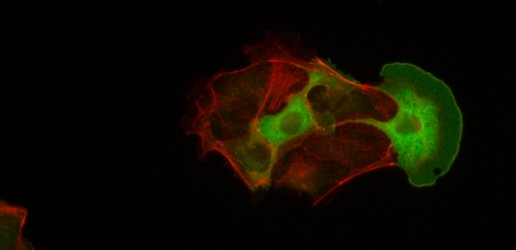 Cytohesin/Arf signaling in HGF stimulated epithelial migration
Cytohesin/Arf signaling in HGF stimulated epithelial migration
HGF (hepatocyte growth factor) is a small protein that potently stimulates migration in a wide variety of epithelial cells. HGF is upregulated in response to tissue damage and enhanced HGF signaling is correlated with metastatic development in a number of cancers. Members of the Arf family of small GTPases are protein switches that control membrane remodeling and signaling events. Enhanced expression of the Arf-activating cytohesin proteins in epithelial cells mimics the treatment of these cells with HGF. Furthermore blocking cytohesin or Arf function prevents HGF from stimulating epithelial migration. We have found that cytohesin/Arf signaling promotes the activation of Rac, a protein that directly stimulates the remodeling of cell shape. Several projects in the lab are focused on understanding how HGF stimulates cytohesin activity and how cytohesin/Arf activation promotes the activation of Rac.
Cytohesin/Arf regulation of adhesion receptor recycling
Adhesion receptors create spots where cells are anchored down to the underlying extracellular matrix. These attachments provide traction points that the cells pull against while migrating. During migration old receptor complexes are internalized and recycled to make new attachment spots. We have found that cytohesin-2 is required for the recycling of these receptors to the cell surface. We are investigating the signals that stimulate cytohesin-2 to promote the formation of new adhesion receptor complexes.
Cytohesin splice variant functions
The cytohesins are each made in two different versions by alternative splicing. We have found that one of these splice variants is required for adhesion receptor recycling while the other plays no role in this process. These splice variants differ in their lipid binding specificity. We are investigating the unique roles of these different splice variants.
Recovery from acute kidney injury
Acute Kidney Injury (AKI) is a serious complication in hospitalized patients, particularly for patients in intensive care. Production of both HGF and the HGF receptor is upregulated in the injured kidney. HGF stimulates the kidney epithelial cells that survived the initial insult to migrate and repopulate the kidney tubules. We are using an in vivo model of AKI to investigate the involvement of cytohesins in this process. Furthermore we are testing if we can use what we have learned about stimulating cytohesin activity to promote recovery from AKI.


